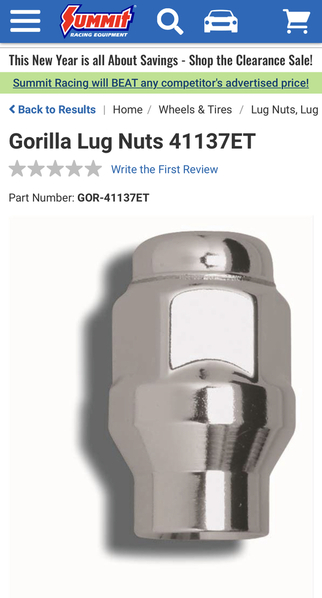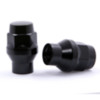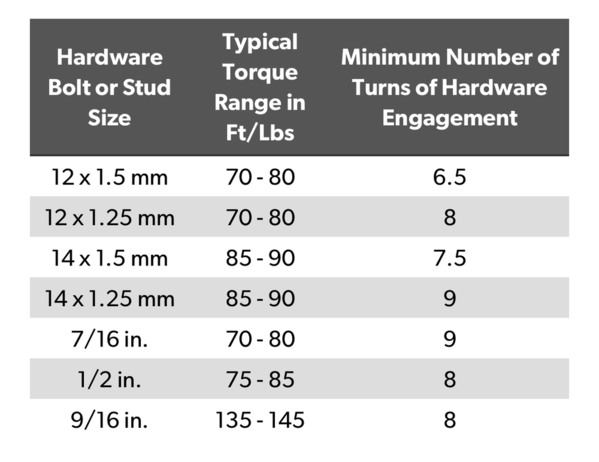The lug nut threads down into the wheel. That's is why I asked you what cone angle the rims require. Normally a 60 degree lug nut is used. You do not need a long stud sticking out beyond the wheel or the nut will never seat unless you use lug nuts with no cover them which looks not so good and unnecessary.
Thanks for the weights, very useful, which compares to16.5 lbs and 14 lbs for magnesium, so not giving up too much unsprung weight.
The rule of thumb is thread engagement should be at minimum the dia. of the stud, so sounds as though you are right at that. The Group 4 and 5 cars had longer wheel studs as the wheel hubs are thicker. Most vendors sell a GT5 stud, but changing the rear will require dismantling the hub assembly and stub axle removal.
Attachments
Took a while to find but here is the black lug nuts.
Attachments
Ok, here is the question: How much thread has to be exposed and out of the wheel for the lug nut to grab onto for it to be considered safe? With the current studs, there is only 1/2 inch of thread that extends past the wheel's stud holes. The stud holes are very small in diameter, only 13 mm, which is 0.512 in. The black lug nuts pictured above by tsolo look really good; however, the shank diameter is 0.61 in. and thus would not fit inside these wheels' stud holes. I need lug nuts with a shank diameter maximum of 13 mm, or 0.512 in. I can't seem to find them. Does anyone know where I can get some? I am trying to avoid changing out the studs, and as joules explained, it sounds like a pain in the butt.
I don't think you can find a shank nut with Ø13mm OD and M12 thread. That would cause a thin wall thickness that wouldn't carry any load.
-Sami
That is what I am afraid of, and you just confirmed it with your opinion. Thank you.
I think I am left with the only safe option of having to change out the studs. There is so much more work involved with that. I was hoping this was an easier and less expensive project than it has proven to be.
The chart David supplied looks very helpful. I must have missed something though. Wouldn't your Gt5 being a wide body have came from the factory with longer studs?
I would ask Roin for his advice. Can you take a close up picture of the hole area?
I looked at a picture I had of the Roin wheel. your stud is sticking out 1/2" from WHERE on the wheel. The outer surface, the inner cone area? I assume you mean the outer surface. If yes, then you have more stud down inside the cone taper. I would not use studs with a shank as shown. Get a stud that has the correct taper angle and if I believe it will be fine. You will have way more than 1/2" of thread engagement. Send a picture of the wheel on the car.
1/2" from the inner cone area, so there will be 1/2" thread engagement with a conical lug nut. But, at 12 mm diameter, according to various posts, 12 mm is apparently all the engagement it needs, right? (Rule of thumb being thread engagement should equal diameter of lug nut.) 1/2" is 12.7 mm. Or am I missing something?
I also asked Roin, and he said there is no need to change the studs. I just want to be absolutely positive. A lot of folks on this forum are a lot more knowledgeable than I am about the subject.
I was suggesting you ask Roin what type of lug nut to use.
Sorry panterapatt, I misunderstood you. I did email Roin and asked Andrea to provide me with prices on the matching lug nuts, which he has. Given the hell I went through with UPS in getting the wheels, I really wish I had ordered lug nuts from Roin when I ordered the wheels. Waiting to hear back from him.
Also, when I get home, I will put one wheel on the car and take a picture and post it. That should give a better idea as to how far the studs come through the wheel's holes.
Just want to thank everyone for their input thus far.
Sounds like a good plan. I would try one of your existing lug nuts on the wheel and count the number of threads you get
Assuming the wheels are machined specifically for a Pantera and are hub-centric you don't need or want lug nuts with a shank. As stated by others, the seat angle and thread engagement are the main concerns. Confirming the seat angle is a good idea. Minimum thread engagement being equal to the thread diameter is valid. Do the wheels have seat inserts? Once the wheel/tire package is mounted on the car and torqued to spec and you drive around a bit, I suggest rechecking the torque after it cools down.
Correct, lug nuts with shanks do not fit the new wheels at all.
Roin got back to me that they no longer carry the lug nuts.
So here is what I learned. I put the Hall Ultra wheel back on and the lug nut with the shank turned exactly 8 turns before it got tight enough that I could not turn it by hand. I went to the local auto store and bought a M12x1.5 conical lug nut (60 degree angle) and tried it on the new Roin wheels. It turned exactly 4 1/2 times before I could not turn it any more. It sat perfectly, so the seat angle is correct at 60 degrees; however, the studs are definitely not long enough for these wheels and need to be changed out.
And to answer otis' earlier question, I covered the history of my car in another post, but the short of it is that it was imported to the U.S. from Europe (not sold through Lincoln/Ford dealerships here) and was later converted into the GT5 some time in the 1980s, so it does not have the longer studs. It is now obvious to me that the wider Hall Ultra wheels were designed to work with the standard studs.
Is removing the studs a DIY project? I am pretty handy around cars, but I haven't done one outside of a dune buggy about 30 years ago, which I recall was rather simple.
Not following. If the exposed thread is 1/2" and you are turning the nut down into the wheel, clearly MORE than 1/2" of thread is being consumed by the nut. If you need a minimum of the diameter of the stud (1/2") of engagement, you have MORE than 1/2" happening. FORGET what the Hall wheel turns are. Gary's wheel has a thinner center, that's all - irrelevant data.
Changing all the studs is a BIG job. take the entire real suspension off.
If you have more than 1/2 an inch of stud being consumed when you thread the nut on which you have to have, I would run them. Remember, there is zero value in having a stud longer than what the nut needs.
I also do not believe Roin purposely made these such that the studs needs to be replaced. He has sold plenty of the wheels.
That is what I would do.
A suggestion to determine how deep the studs are actually engaging with the new lug nuts…..
Roll up some small balls from aluminum foil or modeling clay and stick them inside a lug nut, then install it to its full depth. Might take a few trials to get it right, start small, but that should tell you how far the threads are engaging into the lug nut.
Larry







